The Effects of Nanoparticle Reinforcement on the Micromilling Process of A356/Al2O3 Nanocomposites
Abstract
:1. Introduction
2. Materials and Methods
2.1. Workpiece Materials and Specimen Production
2.2. Machines, Tools, and Measurements
2.3. Experimental Plan and Cutting Conditions
2.4. Cutting Force Measurement and Tool Wear Analysis
2.5. Surface Analysis and Burr Measurements
3. Results
3.1. This Density and Hardness
3.2. Cutting Mechanisms and Cutting Forces
3.3. Tool Wear Analysis
3.4. Surface and Burr Formation Analysis
4. Conclusions
Author Contributions
Funding
Data Availability Statement
Conflicts of Interest
References
- Raj, P.; Biju, P.L.; Deepanraj, B.; Menachery, N. A Systematic Review on Characterization of Hybrid Aluminium Nanocomposites. Mater. Today Proc. 2022, 72, 2139–2150. [Google Scholar] [CrossRef]
- Francois, C.; Poirier, J.P.; Trudel, Y. Enhancing Machinability of P/M Materials. J. Manuf. Mater. Process. 1994, 103, 193–199. [Google Scholar]
- Safari, J.; Akbari, G.H.; Delshad Chermahini, M. The Effect of Reinforcement Content and Milling Time on Microstructure and Mechanical Properties of Al-10Mg/XAl2O3 Nanocomposites. Mater. Sci. Eng. A 2013, 569, 86–91. [Google Scholar] [CrossRef]
- Gururaja, S.; Ramulu, M.; Pedersen, W. Machining of MMCs: A Review. Mach. Sci. Technol. 2013, 17, 41–73. [Google Scholar] [CrossRef]
- Na, H.B.; Xu, L.H.; Han, G.C.; Liu, S.K.; Lu, L.H. Machinability Research on the Micro-Milling for Graphene Nano-Flakes Reinforced Aluminum Alloy. Metals 2019, 9, 1102. [Google Scholar] [CrossRef] [Green Version]
- Ezatpour, H.R.; Torabi Parizi, M.; Sajjadi, S.A.; Ebrahimi, G.R.; Chaichi, A. Microstructure, Mechanical Analysis and Optimal Selection of 7075 Aluminum Alloy Based Composite Reinforced with Alumina Nanoparticles. Mater. Chem. Phys. 2016, 178, 119–127. [Google Scholar] [CrossRef]
- Rahimian, M.; Parvin, N.; Ehsani, N. Investigation of Particle Size and Amount of Alumina on Microstructure and Mechanical Properties of Al Matrix Composite Made by Powder Metallurgy. Mater. Sci. Eng. A 2010, 527, 1031–1038. [Google Scholar] [CrossRef]
- Chambers, A.R. The Machinability of Light Alloy MMCs. Compos. Part A Appl. Sci. Manuf. 1996, 27, 143–147. [Google Scholar] [CrossRef]
- Sankar, B.R.; Umamaheswarrao, P. Multi Objective Optimal Scheme for Machinability Aspects of Al6061-SiCp Metal Matrix Composite during End Milling—A Hybrid Approach. Mater. Today Proc. 2020, 21, 1260–1264. [Google Scholar] [CrossRef]
- Milan, M.T.; Bowen, P. Tensile and Fracture Toughness Properties of SiCp Reinforced Al Alloys: Effects of Particle Size, Particle Volume Fraction, and Matrix Strength. J. Mater. Eng. Perform. 2004, 13, 775–783. [Google Scholar] [CrossRef]
- Mazahery, A.; Abdizadeh, H.; Baharvandi, H.R. Development of High-Performance A356/Nano-Al2O3 Composites. Mater. Sci. Eng. A 2009, 518, 61–64. [Google Scholar] [CrossRef]
- Sunar, T.; Özyürek, D. Effect of Al2O3 nanoparticles as reinforcement on the wear properties of A356/Al2O3 nanocomposites produced by powder metallurgy. J. Tribol. 2022, 144, 081701. [Google Scholar] [CrossRef]
- Asm, I. Machining of Aluminum Alloys. In ASM Handbook; ASM International: Almelle, The Netherlands, 1989; Volume 16, pp. 761–804. [Google Scholar]
- Rodrigues, A.R.; Jasinevicius, R.G. Machining Scale: Workpiece Grain Size and Surface Integrity in Micro End Milling. In Microfabrication and Precision Engineering, 2nd ed.; Davim, J.P., Ed.; Woodhead Publishing: Sawston, UK, 2017; pp. 27–68. [Google Scholar]
- Popov, K.; Dimov, S.; Pham, D.T.; Minev, R.; Rosochowski, A.; Olejnik, L.; Richert, M. The Effects of Material Microstructure in Micro-Milling. In 4M 2006—Second International Conference on Multi-Material Micro Manufacture, 2nd ed.; Menz, M., Dimov, S., Fillon, B., Eds.; Elsevier Ltd.: Amsterdam, The Netherlands, 2006; pp. 127–196. [Google Scholar]
- Joel, J.; Anthony Xavior, M. Optimization on Machining Parameters of Aluminium Alloy Hybrid Composite Using Carbide Insert. Mater. Res. Express 2019, 6, 116532. [Google Scholar]
- Liu, J.; Li, J.; Xu, C. Cutting Force Prediction on Micromilling Magnesium Metal Matrix Composites with Nanoreinforcements. J Micro Nanomanuf. 2013, 1, 011010. [Google Scholar] [CrossRef]
- Li, J.; Liu, J.; Xu, C. Machinability Study of Sic Nano-Particles Reinforced Magnesium Nanocomposites During Micro-Milling Processes. In Proceedings of the International Manufacturing Science and Engineering Conference, Erie, PA, USA, 2–3 July 2010; pp. 391–398. [Google Scholar]
- Premnath, A.A.; Alwarsamy, T.; Rajmohan, T. Experimental Investigation and Optimization of Process Parameters in Milling of Hybrid Metal Matrix Composites. Mater. Manuf. Process. 2012, 27, 1035–1044. [Google Scholar] [CrossRef]
- Parenti, P.; Cazzani, A.; Annoni, M. Cutting force modelling in green machining of polymer-based metallic feedstock. J. Mater. Process. Technol. 2023, 312, 117825. [Google Scholar] [CrossRef]
- Campos, F.d.O.; Mougo, A.L.; Araujo, A.C. Study of the Cutting Forces on Micromilling of an Aluminum Alloy. J. Brazilian Soc. Mech. Sci. Eng. 2017, 39, 1289–1296. [Google Scholar] [CrossRef]
- Liu, J.; Cheng, K.; Ding, H.; Chen, S. Realization of Ductile Regime Machining in Micro-Milling SiCp/Al Composites and Selection of Cutting Parameters. Proc. Inst. Mech. Eng. Part C 2019, 233, 4336–4347. [Google Scholar] [CrossRef]
- Liu, J.; Cheng, K.; Ding, H.; Chen, S.; Zhao, L. An Investigation of the Influence of Phases’ Removal Ways on Surface Quality in Micro Milling SiCp/Al Composites. Procedia CIRP 2018, 71, 59–64. [Google Scholar] [CrossRef]
- Jeyakumar, S.; Marimuthu, K.; Ramachandran, T. Prediction of Cutting Force, Tool Wear and Surface Roughness of Al6061/SiC Composite for End Milling Operations Using RSM. J. Mech. Sci. Technol. 2013, 27, 2813–2822. [Google Scholar] [CrossRef]
- Teng, X.; Huo, D.; Wong, W.L.E.; Sankaranarayanan, S.; Gupta, M. Machinability investigation in micro-milling of Mg based MMCs with nano-sized particles. In Magnesium Technology; Springer International Publishing: Cham, Switzerland, 2017; pp. 61–69. [Google Scholar]
- Pramanik, A.; Zhang, L.C.; Arsecularatne, J.A. Prediction of Cutting Forces in Machining of Metal Matrix Composites. Int. J. Mach. Tools Manuf. 2006, 46, 1795–1803. [Google Scholar] [CrossRef] [Green Version]
- Pramanik, A.; Zhang, L.C.; Arsecularatne, J.A. Machining of Metal Matrix Composites: Effect of Ceramic Particles on Residual Stress, Surface Roughness and Chip Formation. Int. J. Mach. Tools Manuf. 2008, 48, 1613–1625. [Google Scholar] [CrossRef] [Green Version]
- Teng, X.; Huo, D.; Chen, W.; Wong, E.; Zheng, L.; Shyha, I. Finite Element Modelling on Cutting Mechanism of Nano Mg/SiC Metal Matrix Composites Considering Cutting Edge Radius. J. Manuf. Process. 2018, 32, 116–126. [Google Scholar] [CrossRef] [Green Version]
- Manna, A.; Bhattacharayya, B. A Study on Machinability of Al/SiC-MMC. J. Mater. Process. Technol. 2003, 140, 711–716. [Google Scholar] [CrossRef]
- Manna, A.; Bhattacharayya, B. Influence of Machining Parameters on the Machinability of Particulate Reinforced Al/SiC-MMC. Int. J. Adv. Manuf. Technol. 2005, 25, 850–856. [Google Scholar] [CrossRef]
- Afsharhanaei, A.; Rebaioli, L.; Parenti, P.; Annoni, M. Finite element modeling of micro-orthogonal cutting process with dead metal cap. Proc. Inst. Mech. Eng. Part B 2018, 232, 1351–1361. [Google Scholar] [CrossRef]
- Yousefi, R.; Kouchakzadeh, M.A.; Rahiminasab, J.; Kadivar, M.A. The Influence of SiC Particles on Tool Wear in Machining of Al/SiC Metal Matrix Composites Produced by Powder Extrusion. Adv. Mater. Res. 2011, 325, 393–399. [Google Scholar] [CrossRef]
- Baruffi, F.; Parenti, P.; Cacciatore, F.; Annoni, M.; Tosello, G. On the application of replica molding technology for the indirect measurement of surface and geometry of micromilled components. Micromachines 2017, 8, 195. [Google Scholar] [CrossRef] [Green Version]
- Suryanarayana, C. Mechanical Alloying and Milling. Prog. Mater. Sci. 2001, 46, 1–184. [Google Scholar] [CrossRef]
- Sun, X.; Cheng, K. Chapter 2—Micro-/Nano-Machining through Mechanical Cutting. In Micromanufacturing Engineering and Technology, 2nd ed.; Qin, Y., Ed.; William Andrew: Norwich, NY, USA, 2015; pp. 35–58. [Google Scholar]
- Thakre, A.A.; Soni, S. Modeling of Burr Size in Drilling of Aluminum Silicon Carbide Composites Using Response Surface Methodology. Eng. Sci. Technol. Int. J. 2016, 19, 1199–1205. [Google Scholar] [CrossRef] [Green Version]
- Chen, J.P.; Gu, L.; He, G.J. A Review on Conventional and Nonconventional Machining of SiC Particle-Reinforced Aluminium Matrix Composites. Adv. Manuf. 2020, 8, 279–315. [Google Scholar] [CrossRef]

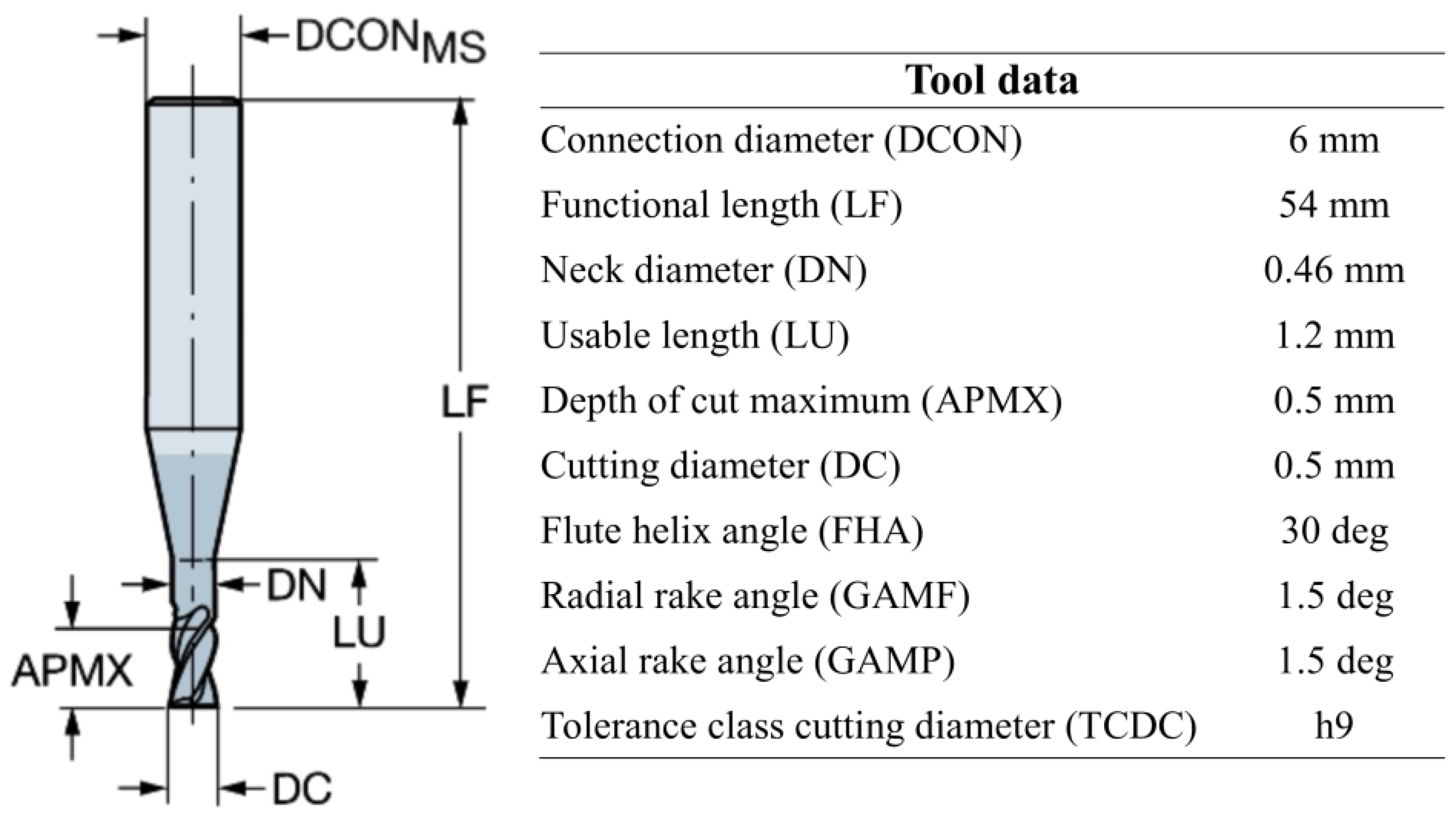
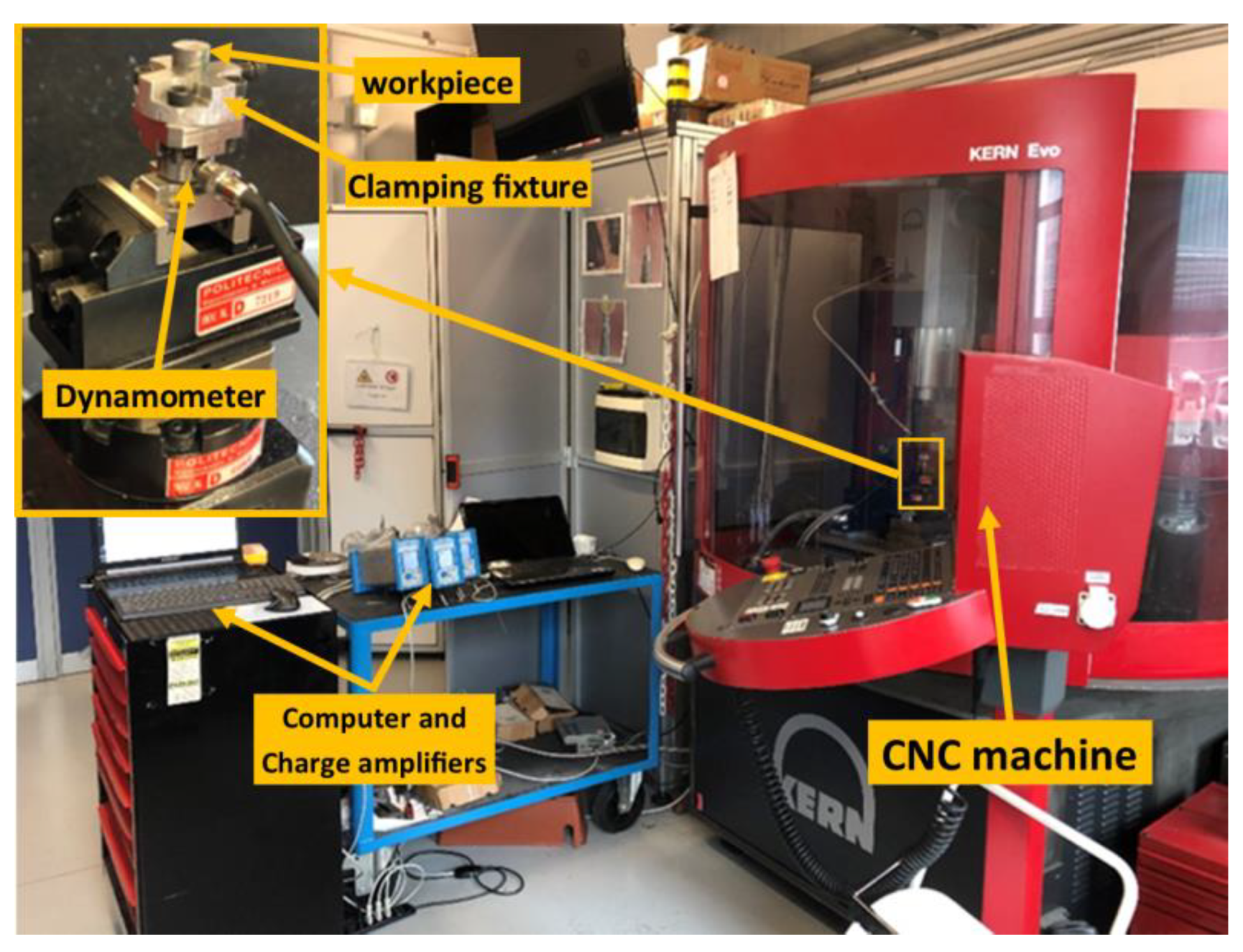

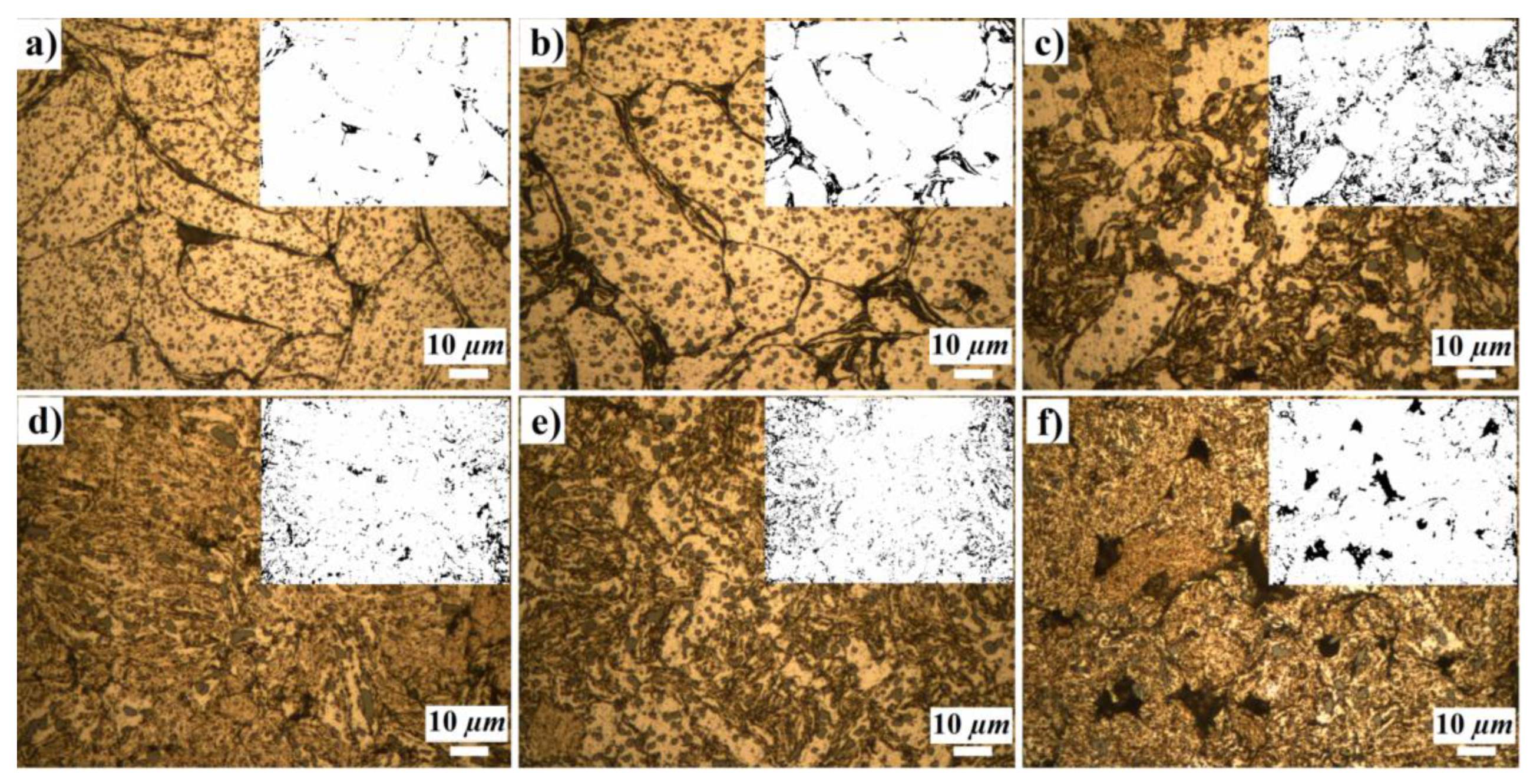
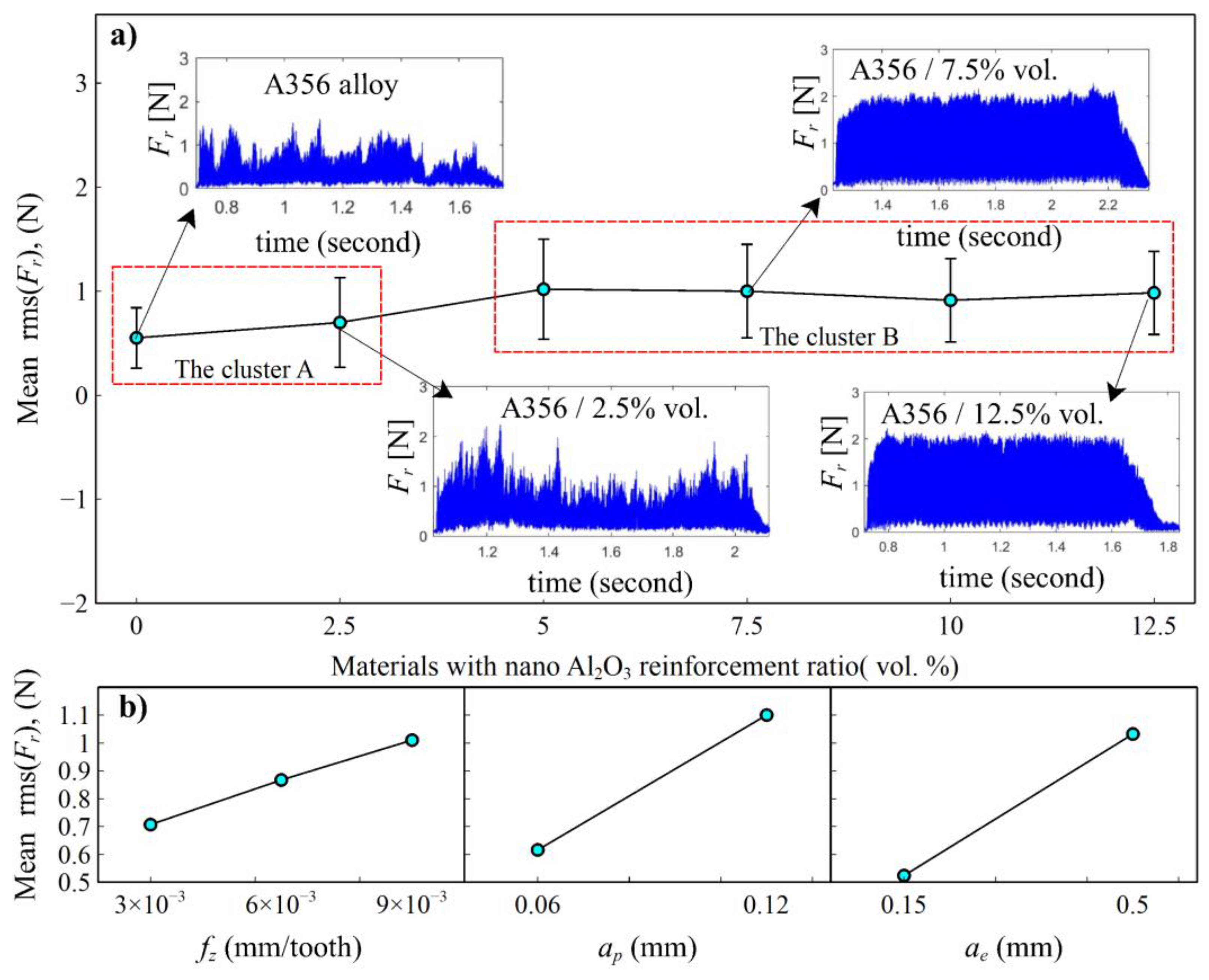

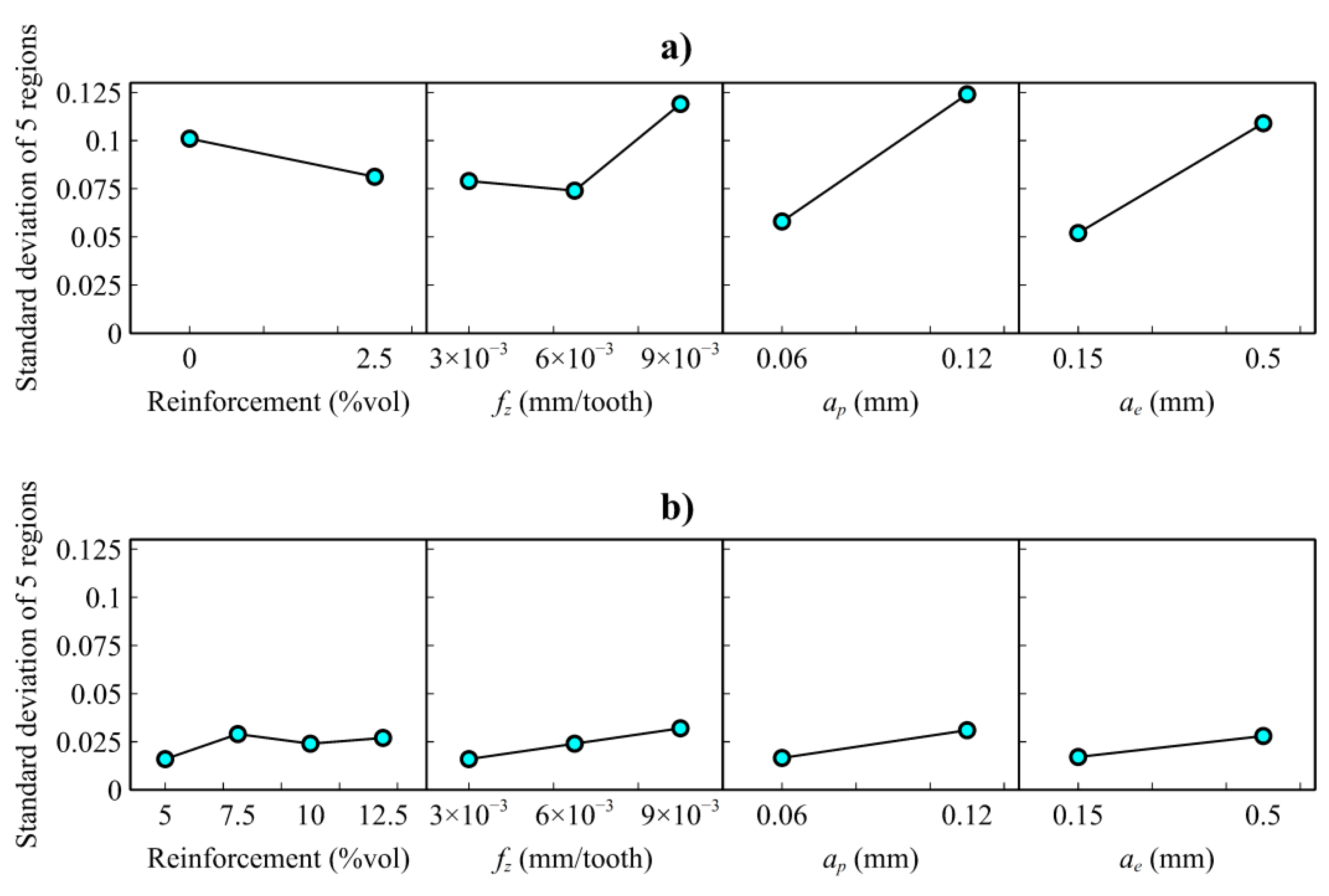


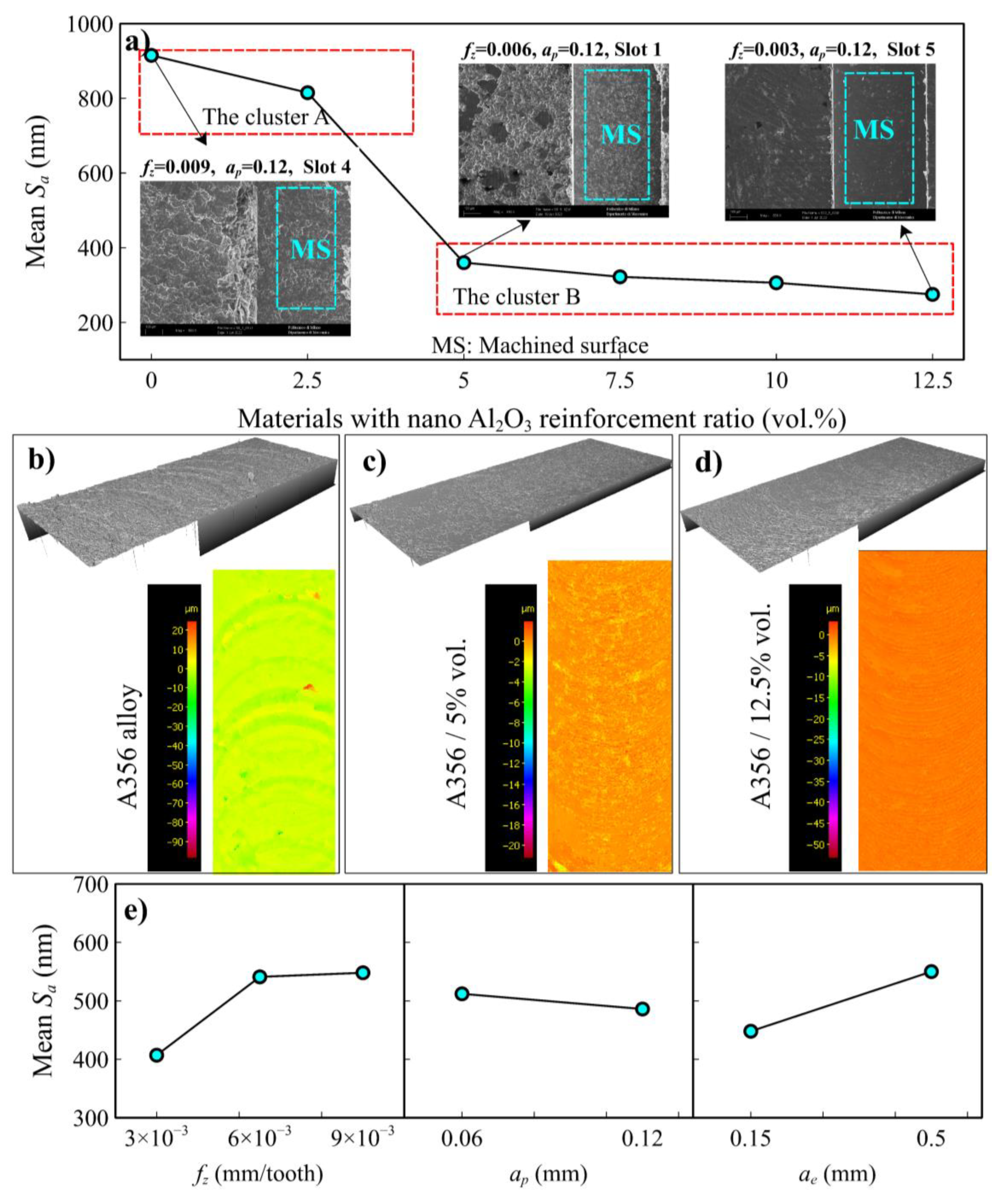

| Factors | Levels |
|---|---|
| Al2O3 reinforcement (vol.%) | 0/2.5/5/7.5/10/12.5 |
| ƒz—Feed/tooth (µm) | 3/6/9 |
| αe—Radial depth of cut (µm) | 0.15/0.5 |
| αp—Axial depth of cut (µm) | 60/120 |
| Source | DF | F-Value | p-Value |
|---|---|---|---|
| Reinforcement Ratio (% vol.) | 5 | 26.770 | 0 |
| ƒz (mm) | 2 | 34.420 | 0 |
| αp (mm) | 1 | 236.530 | 0 |
| αe (mm) | 1 | 344.940 | 0 |
| Reinforcement Ratio ∗ ƒz | 10 | 0.440 | 0.924 |
| Reinforcement Ratio ∗ αp | 5 | 1.130 | 0.348 |
| Reinforcement Ratio ∗ αe | 5 | 2.600 | 0.028 |
| ƒz ∗ αp | 2 | 2.130 | 0.123 |
| ƒz ∗ αe | 2 | 7.220 | 0.001 |
| αp ∗ αe | 1 | 37.580 | 0 |
| Reinforcement Ratio ∗ ƒz ∗ αp | 10 | 0.270 | 0.986 |
| Reinforcement Ratio ∗ ƒz ∗ αe | 10 | 0.190 | 0.996 |
| Reinforcement Ratio ∗ αp ∗ αe | 5 | 0.190 | 0.968 |
| ƒz ∗ αp ∗ αe | 2 | 0.930 | 0.398 |
| Reinforcement Ratio ∗ ƒz ∗ αp ∗ αe | 10 | 0.150 | 0.999 |
| Cluster A | Cluster B | All Together | |
|---|---|---|---|
| Source | p-Value | p-Value | p-Value |
| Reinforcement Ratio (% vol.) | 0.394 | 0.092 | 0.000 |
| ƒz (mm) | 0.078 | 0.007 | 0.004 |
| αp (mm) | 0.001 | 0 | 0.000 |
| αe (mm) | 0.001 | 0.002 | 0.000 |
| Reinforcement Ratio ∗ ƒz | 0.596 | 0.508 | 0.558 |
| Reinforcement Ratio ∗ αp | 0.391 | 0.949 | 0.015 |
| Reinforcement Ratio ∗ αe | 0.371 | 0.703 | 0.004 |
| ƒz ∗ αp | 0.657 | 0.8 | 0.540 |
| ƒz ∗ αe | 0.355 | 0.089 | 0.260 |
| αp ∗ αe | 0.339 | 0.408 | 0.220 |
| Reinforcement Ratio ∗ ƒz ∗ αp | 0.524 | 0.424 | 0.835 |
| Reinforcement Ratio ∗ ƒz ∗ αe | 0.687 | 0.928 | 0.807 |
| Reinforcement Ratio ∗ αp ∗ αe | 0.093 | 0.696 | 0.126 |
| ƒz ∗ αp ∗ αe | 0.226 | 0.44 | 0.127 |
| Reinforcement Ratio ∗ ƒz ∗ αp ∗ αe | 0.19 | 0.899 | 0.203 |
| Cluster A | Cluster B | All Together | |
|---|---|---|---|
| Source | p-Value | p-Value | p-Value |
| Reinforcement Ratio (% vol.) | 0.312 | 0.052 | 0 |
| ƒz (mm) | 0.294 | 0 | 0.004 |
| αp (mm) | 0.484 | 0.252 | 0.839 |
| αe (mm) | 0.005 | 0.566 | 0.004 |
| Reinforcement Ratio ∗ ƒz | 0.879 | 0.635 | 0.995 |
| Reinforcement Ratio ∗ αp | 0.295 | 0.676 | 0.451 |
| Reinforcement Ratio ∗ αe | 0.58 | 0.782 | 0.013 |
| ƒz ∗ αp | 0.971 | 0.982 | 0.98 |
| ƒz ∗ αe | 0.612 | 0.967 | 0.703 |
| αp ∗ αe | 0.286 | 0.423 | 0.198 |
| Reinforcement Ratio ∗ ƒz ∗ αp | 0.321 | 0.959 | 0.759 |
| Reinforcement Ratio ∗ ƒz ∗ αe | 0.111 | 0.977 | 0.176 |
| Reinforcement Ratio ∗ αp ∗ αe | 0.535 | 0.316 | 0.66 |
| ƒz ∗ αp ∗ αe | 0.773 | 0.902 | 0.711 |
| Reinforcement Ratio ∗ ƒz ∗ αp ∗ αe | 0.324 | 0.906 | 0.707 |
Disclaimer/Publisher’s Note: The statements, opinions and data contained in all publications are solely those of the individual author(s) and contributor(s) and not of MDPI and/or the editor(s). MDPI and/or the editor(s) disclaim responsibility for any injury to people or property resulting from any ideas, methods, instructions or products referred to in the content. |
© 2023 by the authors. Licensee MDPI, Basel, Switzerland. This article is an open access article distributed under the terms and conditions of the Creative Commons Attribution (CC BY) license (https://creativecommons.org/licenses/by/4.0/).
Share and Cite
Sunar, T.; Parenti, P.; Tunçay, T.; Özyürek, D.; Annoni, M. The Effects of Nanoparticle Reinforcement on the Micromilling Process of A356/Al2O3 Nanocomposites. J. Manuf. Mater. Process. 2023, 7, 125. https://doi.org/10.3390/jmmp7040125
Sunar T, Parenti P, Tunçay T, Özyürek D, Annoni M. The Effects of Nanoparticle Reinforcement on the Micromilling Process of A356/Al2O3 Nanocomposites. Journal of Manufacturing and Materials Processing. 2023; 7(4):125. https://doi.org/10.3390/jmmp7040125
Chicago/Turabian StyleSunar, Talha, Paolo Parenti, Tansel Tunçay, Dursun Özyürek, and Massimiliano Annoni. 2023. "The Effects of Nanoparticle Reinforcement on the Micromilling Process of A356/Al2O3 Nanocomposites" Journal of Manufacturing and Materials Processing 7, no. 4: 125. https://doi.org/10.3390/jmmp7040125





